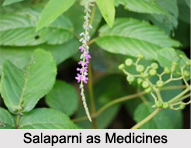 Salaparni is one of the most important Ayurvedic herbs. Its botanical name is Desmodium Gangeticum DC. This little shrub is regarded as febrifuge and anti-catarrhal. It forms an ingredient of the compound decoction called "Dasamula Kvatha", a combination much used in a great variety of diseases.
Salaparni is one of the most important Ayurvedic herbs. Its botanical name is Desmodium Gangeticum DC. This little shrub is regarded as febrifuge and anti-catarrhal. It forms an ingredient of the compound decoction called "Dasamula Kvatha", a combination much used in a great variety of diseases.
Dasamula
Dasamula is made up of Desmodium Gangeticum (Salaparni), Uraria Lagopodioides (Prisniparni), Solatium Jacquinii (Kantakari), Solanum Indicum (Vrihati), Tribilus Terrestris (Gokshura), Aegle Marmelos (Bela), Calosantkes Indica (Syonaka), Gmelina Arborea (Gambhari), Stereospermum Suaveolens (Patala) and Premna Spinosa (Ganikarika). The 10 drugs together are used in remittent fever, puerperal fever, inflammatory affections within the chest, affections of the brain and many other diseases supposed to be caused by derangement of all the humours.
The first 5 in the above list are collectively called "Hrasva Pancha Mula" or the 5 minor plants, and the last 5 are called "Vrihat Pancha Mula" or the 5 major plants. A decoction of the Hrasva Pancha Mula is used in catarrhal fever, cough and other diseases supposed to be caused by deranged phlegm. The Vrihat Pancha Mula is used in fever and other diseases supposed to be caused by deranged air.
Another combination called Ashtadasanga Pachana consists of the 10 drugs above mentioned, with the addition of the 8 following, namely, chiretta, devadaru, ginger, tubers of Cyperus Rotundus (Mustaka), root of Picrorrhiza Kurroa (Katuki), indrajava seeds, coriander and fruits of Pothos Officinalis. A decoction of these 18 drugs is used in fevers of a severe type with drowsiness, delirium, picking of bed clothes, insensibility, and difficult breathing. A preparation of aconite and arsenic is generally given along with it.
Dasamula Taila
Dasamula Taila is an oil prepared with a decoction of the 10 drugs above mentioned and is much used as a cooling application in headache and other diseases. To prepare it take the 10 drugs, all in 12 seers and a half and water 64 seers. Boil down to 16 seers and strain. To the strained decoction add 4 seers of lemon juice, 4 seers of prepared sesamum oil and a seer of the usual aromatics and colouring agents in the form of a paste and boil them together.
Related Articles
Ayurveda Medication
Elements of Ayurveda
Concepts of Ayurveda
Ancient Literature of Ayurveda
Classification of Medicine




















